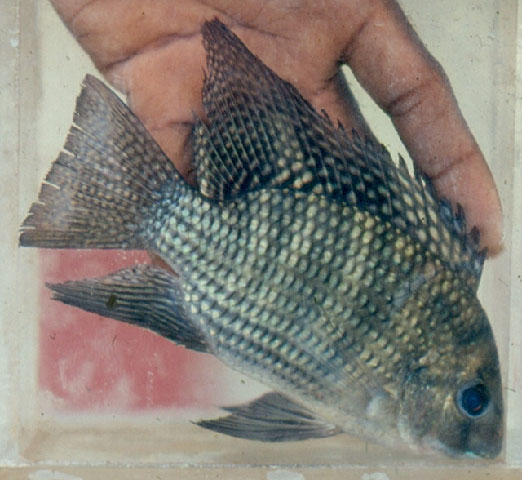| Cichlidae (Cichlids), subfamily: Pseudocrenilabrinae |
| 16.1 cm TL (male/unsexed) |
|
demersal; freshwater, |
| Africa: at present only known from and probably endemic to the St. Paul River, Liberia (Ref. 52307, 53405). |
|
Dorsal spines (total): 13-15; Dorsal soft rays (total): 14-16; Anal spines: 3-3; Anal soft rays: 9-11. Diagnosis: lower pharyngeal bone about as long as broad, with anterior lamella shorter than toothed area; median pharyngeal teeth not broadened; dorsal and caudal fins densily blotched; dorsal fin with 13-15 spines and 14-17 soft rays (mean 14.15); 9-12 lower gill-rakers (Ref. 53405).
Description: body rather deep, its depth 46.3-55.3% of standard length; outer jaw teeth bicuspid and non-spatulate, inner jaw teeth tricuspid, posterior pharyngeal teeth tricuspid, median pharyngeal teeth not broadened; micro-gillrakers present; scales cycloid (Ref. 53405).
Coloration: in life: ground colour silvery (Ref. 53405), tinged with bluish-green (Ref. 52307, 53405) on sides and greyish-green on back (Ref. 53405). Top of snout and head grey to greyish-green, upper lip and corners of lower lip bluish-green; anterior part of lower lip, as well as throat and belly, whitish; dark bar from eye to corner of mouth (Ref. 53405). Scales on sides with dark bar at base (Ref. 52307, 53405), dorsal scales dark-edged and lighter (greyish-green) at centre, giving a spotted pattern (Ref. 53405). Pectoral fins transparent; dorsal fin dark grey, covered with numerous transparent or whitish round spots which are larger and aligned in 3-4 oblique series on spinous part, smaller and more numerous on soft part; indistinct outline of "tilapian" spot visible in adults; distal margin of dorsal fin dark grey to blackish; caudal fin white-spotted like dorsal, but with dark hind margin (Ref. 53405). Pelvic fins black (Ref. 52307, 53405). Anal fin blackish distally, white-spotted proximally; in subadults, distal margin of dorsal fin sometimes dark red but occasionally entire dorsal and caudal fins may be reddish (Ref. 53405). |
| Probably pair-bonding, open substratum spawner, with both parents guarding the brood (Ref. 52307). |
|
Critically Endangered (CR); Date assessed: 17 August 2019 (B2ab(iii)) Ref. (130435)
|
| harmless |
|
Source and more info: www.fishbase.org. For personal, classroom, and other internal use only. Not for publication.

